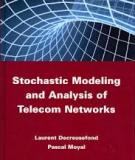
Ergodic Markov chains
-
Information retrieval techniques: Lecture 37. The main topics covered in this chapter include: markov chains; ergodic markov chains; markov chain with teleporting; query processing; personalized pagerank;... Please refer to the content of document.
 14p
14p  tieuvulinhhoa
tieuvulinhhoa
 22-09-2022
22-09-2022
 24
24
 4
4
 Download
Download
-
This book addresses the stochastic modeling of telecommunication networks, introducing the main mathematical tools for that purpose, such as Markov processes, real and spatial point processes and stochastic recursions, and presenting a wide list of results on stability, performances and comparison of systems. The authors propose a comprehensive mathematical construction of the foundations of stochastic network theory: Markov chains, continuous time Markov chains are extensively studied using an original martingale-based approach.
 385p
385p  titatu_123
titatu_123
 01-03-2013
01-03-2013
 64
64
 8
8
 Download
Download
-
Transient Solution of Markov Chains Transient solution is more meaningful than steady-state solution when the system under investigation needs to be evaluated with respect to its shortterm behavior, Using steady-state measures instead of transient measures could lead to substantial errors in this case. Furthermore, applying transient analysis is the onl y choice if non-ergodic models are investigated, Transient analysis of Markov chains has been attracting increasing attention and is of particular importance in dependability modeling. ...
 31p
31p  vaseline
vaseline
 23-08-2010
23-08-2010
 94
94
 11
11
 Download
Download
-
Steady-State Solutions of Markov Chains In this chapter, we restrict ourselves to the computation of the steady-state probability vector’ of ergo&c Markov chains. Most of the literature on solution techniques of Markov chains assumes ergodicity of the underlying model. A comprehensive source on algorithms for steady-state solution techniques is the book by Stewart [Stew94]. From Eq. (2.15) and Eq. (2.58), we have v = VP and 0 = nQ, respectively, as points of departure for the study of steady-state solution techniques. Eq. (2.15) can be transformed so that: 0 = Y(P -1).
 49p
49p  vaseline
vaseline
 23-08-2010
23-08-2010
 109
109
 23
23
 Download
Download
CHỦ ĐỀ BẠN MUỐN TÌM
















